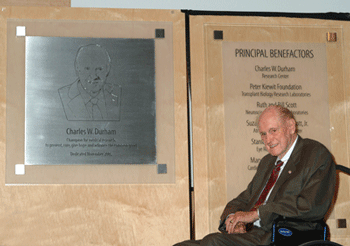 |
Chuck Durham in 2003 when the plaque was unveiled in the newly constructed Durham Research Center. |
On Monday, the UNMC community remembered Durham, who died Saturday (April 5) at age 90, for his visionary leadership, philanthropic spirit and the indelible impact, he and his late wife, Margre, had on UNMC, where their names are synonymous with research excellence.
“Chuck Durham was sincerely interested in building a strong nationally recognized research program at UNMC, because he felt that he could do more, for more people, through research than through any other mechanism,” said UNMC Chancellor Harold M. Maurer, M.D. “He would say that his gifts got things started and that he did nothing beyond this. He attributed all of UNMC’s success in biomedical research to the scientists who used the facilities to their best advantage.”
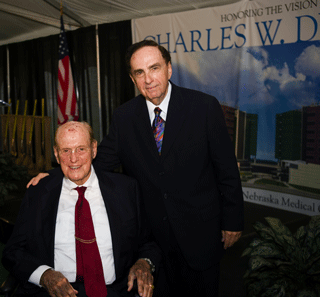 |
Chuck Durham, left, and Chancellor Harold M. Maurer, M.D. |
In 2003, the 10-level, $77 million Durham Research Center opened and the Research Center of Excellence II, as it is presently being called, is expected to open in early 2009. The building, which will be nearly identical to the Durham Research Center, will tower over a commemorative sculpture of Durham that UNMC has commissioned by Omaha artist John Labja.
|
|
The spirit of Durham’s giving is captured in a 14-word inscription, which hangs in the DRC on a plaque under his likeness: “Champion for medical research to prevent, cure, give hope and advance the common good.”
“He was so proud of getting us started that, in his office, he hung posters of the science that was being performed at the Durham Research Center,” Dr. Maurer said. “In addition, Chuck’s gifts changed the culture toward biomedical research, not only at the medical center, but also in Nebraska, in advancing the health care for Nebraskans and beyond. His lasting legacy validated the importance of gift giving to the medical center to advance health care for mankind.”
John Niemann, Ed.D., senior vice president of the University of Nebraska Foundation, agreed. “He wanted to leave a gift for all of Nebraska that would endure for years. The buildings are monuments to his corporate genius, but they are really houses of medical invention and enterprise.”
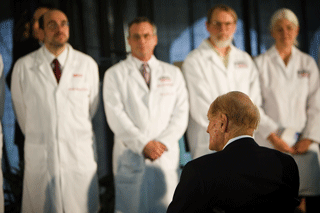 |
Scientists pay tribute to Chuck Durham for his investment in UNMC’s research enterprise. |
In 1998, the Durhams established the Charles W. and Margre H. Durham Excellence in Medicine Fund at UNMC to support research in prostate cancer, arthritis and minimally invasive surgery. Their support made it possible for UNMC to be the eighth medical center in the country to acquire the computer-assisted da Vinci Surgical System. In recognition of their gift, the Outpatient Care Center was renamed the Durham Outpatient Center. Durham’s gifts also made possible the employee parking garage, southeast of the intersection of Emile Street and the Durham Research Plaza.
“Mr. Durham understood very well that the development of a world-class research enterprise requires facilities where the finest scientists can carry out their best work,” said Thomas Rosenquist, Ph.D., vice chancellor for research. “Without his foresight and generosity, UNMC would not be the proud home of the twin towers of research that assure our ability to recruit and retain these outstanding men and women of science. His legacy is not simply in the bricks and mortar, but in the way that the bricks and mortar are able to leverage programmatic advances in research that saves lives.”
On July 6, 2004, 45th Street on the UNMC campus was renamed “Durham Research Plaza,” to reflect the major impact Durham made on research, education and patient care. In addition to the renaming of 45th Street, Durham Research Plaza extends onto Dewey Avenue between 45th and 44th streets, forming an “L” on the UNMC campus.
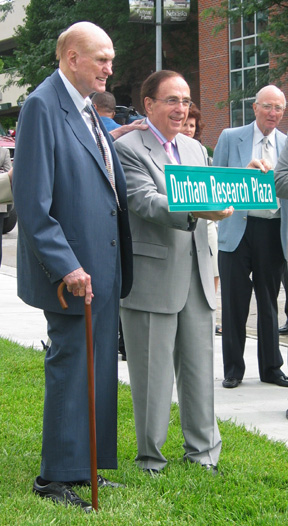 |
Chuck Durham, left, and UNMC Chancellor Harold M. Maurer, M.D., in 2004 with a replica of the Durham Research Plaza sign. |
Born Sept. 28, 1917, in Chicago, Durham grew up in Iowa where he developed a strong, no nonsense work ethic – beginning at age 11 when he rose at 5 a.m. to deliver the Des Moines Register to 40 or 50 houses.
Later, he spent his summers during college working 10 hours a day at 30 cents an hour cutting asparagus on the Ag College farm in Ames, Iowa. The Eagle Scout and avid debater worked his way through Iowa State University, graduating in 1939 with a bachelor’s degree in general engineering. He went on to earn a bachelor’s degree (1940) and a professional degree in civil engineering (1944) at Iowa State.
In 1940, Durham took a job that changed his life when he became a draftsman with H.H. Henningson Engineering Company, a small engineering firm in Omaha. It was the same year he married his college sweetheart, Margre Henningson, who died in 1999.
In 1950, Henningson Engineering Company was reorganized as Henningson, Durham & Richardson Inc. (HDR) and Durham was named president, the position he held until he sold the firm in 1983. When he took over the company, it had 15 employees in its only office. Thirty years later, Durham had built HDR into one of the nation’s top engineering and architectural companies with 1,700 employees and offices in 20 cities. It had contracts in all 50 states and 27 countries.
Durham transformed the rural Midwest through his work on water and electrification projects. He worked on 75 percent of all rural electrification in Nebraska, as well as in western Iowa, northern Kansas and Missouri.
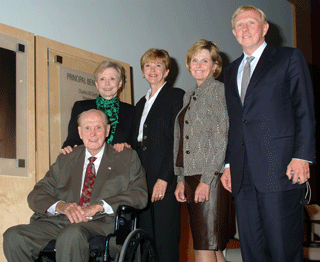 |
The Durham family in a 2003 photo. |
Survivors include his son, Steve Durham of Dallas; daughters, Sunny Lundgren and Lynne Boyer, both of Omaha, and Debby Durham of Fremont, Neb.; nine grandchildren and six great-grandchildren. In recent years, Durham’s constant companion was Tina, a Pekinese-poodle mix adopted from the Nebraska Humane Society.
In his 1998 biography titled “Lucky,” Durham said his name should be “Lucky” Durham because of the blessings that had come his way. On Monday, as UNMC faculty and staff gathered inside the buildings that bear his name, they, too, paused to reflect upon the good fortune of having such a strong ally for the medical center.
Said Niemann: “I’ll always remember he was an eternal optimist. He was the original big thinker. He had the façade of a bull and the heart of a lamb. Nobody could crack the whip harder than he could, but if you got inside you found one of the warmest, good humored human beings you would ever meet. I’m the lucky guy to have known him.”
That sentiment was echoed Monday again and again across the UNMC campus.